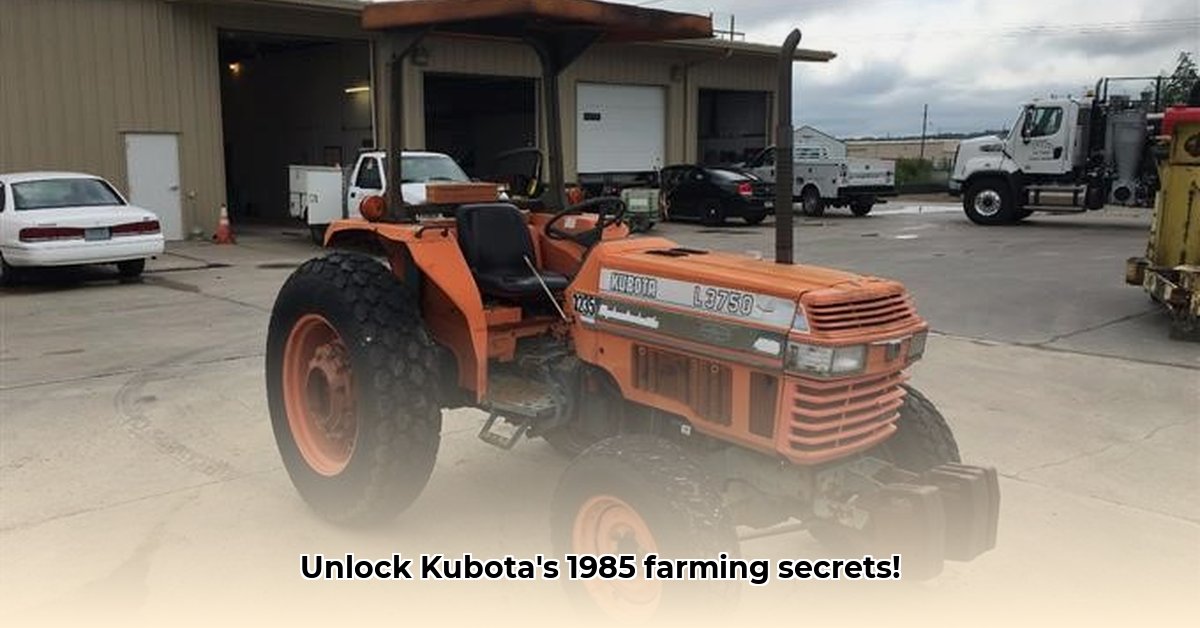
Understanding Your 1985 Kubota Tractor
This guide focuses on maximizing the longevity and efficiency of your 1985 Kubota tractor, a testament to enduring agricultural technology. First, precise identification of your model (e.g., B7100, B1700, L225) is crucial for accessing specific manuals, parts, and maintenance advice. This detailed information will be essential throughout this guide. For more troubleshooting help, check out this helpful resource on Kubota tractor problems.
Technical Specifications and Features
The specifications vary depending on the exact model, but common features of many 1985 Kubotas include:
- Engine: Typically a diesel engine (known for reliability and fuel efficiency relative to gasoline engines of the time), with horsepower ranging from 14 to 22 HP, depending on the model. Specific engine types and variations exist across the model line.
- Transmission: Mostly manual transmissions, offering precise control over power delivery. Specific transmission types vary by model, influencing operational characteristics.
- Three-Point Hitch: A standard feature, enabling easy attachment of implements like plows, harrows, and mowers. Understanding its operation is fundamental to efficient farming.
- Hydraulics: The hydraulic system powers implements and controls attachments; maintaining it properly is essential for operational success.
- PTO (Power Take-Off): This shaft transmits power from the engine to implements, necessitating understanding for safe and efficient use.
Detailed specifications for your specific model can be found in your owner's manual or through online resources dedicated to Kubota tractors.
Operating Your 1985 Kubota Tractor: A Step-by-Step Guide
Safe and efficient operation requires preparation and understanding. Remember, your owner’s manual is your primary reference.
- Pre-Operation Check (Essential): Inspect all fluids (engine oil, coolant, hydraulic fluid), tire pressure, and belts before starting.
- Engine Start-Up: Follow your owner's manual precisely. Generally, engage the clutch, select neutral, and then crank the engine.
- Operation: Select appropriate gear for terrain and task. Maintain constant awareness of your surroundings.
- Implement Usage: Attach and detach implements according to the manufacturer’s instructions. This step is critical for safety and preventing damage.
- Safe Shutdown: Bring the tractor to a complete stop before switching off the engine.
Consistently following these steps ensures safe and effective tractor operation.
Maintaining Your 1985 Kubota: Regular Maintenance Schedule
Preventative maintenance extends the life and efficiency of your tractor. Regular upkeep is far cheaper than emergency repairs.
- Oil Changes: Adhere to the schedule in your owner's manual. Using the correct oil type is essential for engine health.
- Filter Replacements: Regularly replace air, fuel, and hydraulic filters to prevent contaminants from harming the engine and hydraulic system.
- Lubrication: Regularly lubricate moving parts as recommended. This reduces wear and tear, contributing to a longer lifespan.
- Battery Maintenance: Keep battery terminals clean and ensure proper charging. A dead battery can cause significant downtime.
Regular maintenance is not just about avoiding breakdowns, it's about maximizing the lifespan and efficiency of your 1985 Kubota.
Troubleshooting Common Problems
Addressing problems promptly minimizes downtime and potential for larger, more expensive repairs.
| Problem | Possible Causes | Solutions |
|---|---|---|
| Engine Won't Start | Dead battery, low fuel, clogged fuel filter, faulty starter | Check battery, add fuel, replace filter, check starter |
| Hydraulic Issues | Low fluid, faulty pump, leaks, worn seals | Check fluid levels, inspect pump & seals, seek mechanic |
| PTO Problems | Worn belt, clutch problems, broken shaft | Inspect belt, address clutch, check shaft integrity |
For problems beyond basic troubleshooting, consult your owner’s manual or a qualified mechanic.
Sourcing Parts for Your 1985 Kubota Tractor
Finding parts for older equipment requires a strategic approach.
- Kubota Dealers: Your local dealer is the primary source for authentic Kubota parts, ensuring proper fit and function.
- Online Marketplaces: Exercise caution when using online retailers. Thoroughly check seller reviews before purchasing.
- Used Parts Suppliers: Used parts offer cost savings but require careful inspection for wear and tear before installation.
Prioritize parts that meet Kubota's specifications to maintain your tractor's integrity and performance.
Sustainability and Your 1985 Kubota: Eco-Conscious Farming
Using a well-maintained 1985 Kubota offers significant sustainability benefits.
- Extended Lifespan: Reduces demand for new manufacturing and material consumption.
- Fuel Efficiency (relative to its class): Older diesel engines can be surprisingly fuel-efficient compared to contemporary gasoline tractors.
- Reduced Environmental Impact: Minimizes the environmental footprint associated with manufacturing and disposing of a new tractor.
Remember that responsible operation and maintenance are key to maximizing the environmental and economic advantages of your 1985 Kubota.
Conclusion: Extending Your Tractor's Legacy
Your 1985 Kubota represents a durable and potentially sustainable farming solution. By following the maintenance and operational advice in this guide, you can extend its life, minimize repair costs, and contribute to environmentally responsible agricultural practices. Remember to always consult your owner's manual for model-specific information and safety precautions.